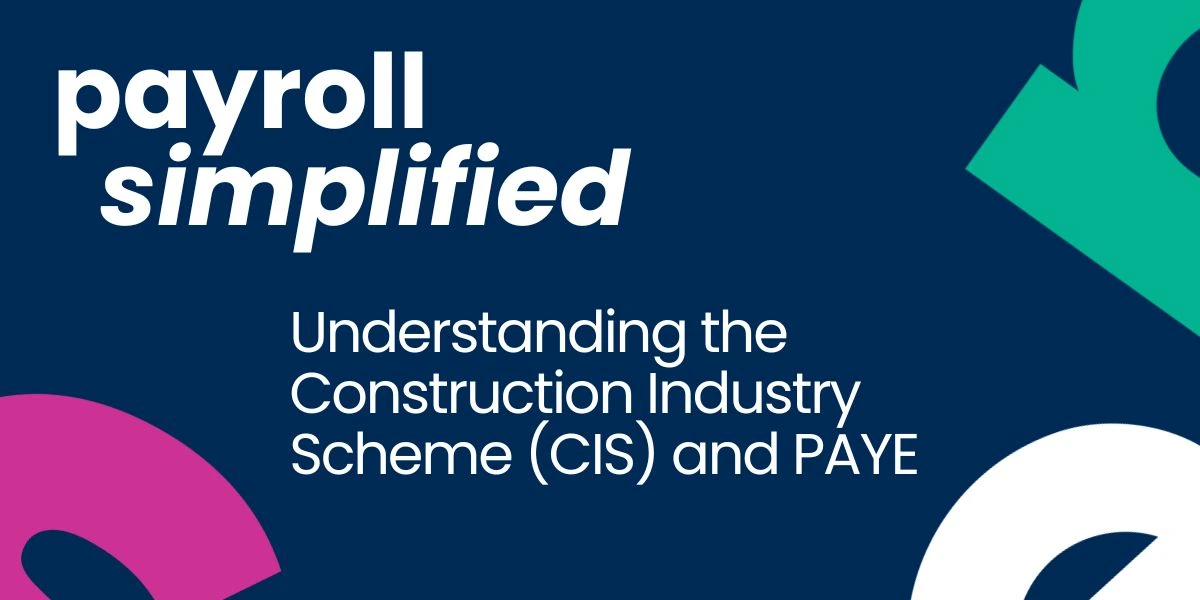If you’re running a construction business in the UK, you’ve probably heard about CIS and PAYE. These two tax systems often work side by side, and understanding how they interact is crucial for staying compliant with HMRC.
It is important to be aware that a business can operate as both a contractor and sub-contractor within the Construction Industry. Here, we consider what obligations there are for contactors.
What is the Construction Industry Scheme (CIS)?
The Construction Industry Scheme is a tax deduction system specifically for the construction industry. It’s HMRC’s way of collecting tax from contractors and subcontractors working in construction.
The basic principle is that when a contractor pays a subcontractor, they usually deduct money from the payment and send it directly to HMRC. Think of it as tax being taken at source, before the subcontractor even receives their money.
Who needs to register for CIS?
Contractors must register if they pay subcontractors for construction work. This includes:
- Construction companies
- Property developers
- Local authorities
- Housing associations
- Businesses that spend more than £3 million on construction in a year
Subcontractors should register too because:
- They will have a lower deduction rate (20% instead of 30%)
- If they don’t register with HMRC as a sub-contractor, contractors must deduct 30% from the payments
How do CIS and PAYE work together?
Here’s where it gets interesting. Many construction businesses operate both PAYE and CIS simultaneously because they have:
- Employees (covered by PAYE)
- Subcontractors (covered by CIS)
The key is understanding that these are two separate systems with different rules and reporting requirements.
The main differences
PAYE applies to employees:
- You deduct Income Tax and National Insurance
- You pay Employers’ National Insurance (ERs)
- Employees have employment rightsYou report monthly via RTI (Real Time Information)
CIS applies to subcontractors:
- You deduct only CIS tax (no National Insurance)
- Subcontractors are self-employed
- They invoice you for work done
- You report monthly using CIS returns
Checks you need to do
Before you pay a subcontractor
Before making any payment to a subcontractor, you must verify their status with HMRC. This is called a ‘verification check’ and must be done before a sub-contractor is paid to ascertain what deduction should be made from the payment.
How to verify:
- Log into HMRC’s online CIS service, which is connected to the employer’s PAYE login with HMRC
- Enter the subcontractor’s details (name, UTR or National Insurance number)
- HMRC tells you whether to deduct 20%, 30%, or 0%
The three possible outcomes:
- Registered subcontractor: Deduct 20%
- Not registered: Deduct 30%
- Gross payment status: Deduct 0%. Gross Payment Status is granted to sub-contractors who have proven to HMRC that they have complied with all of their filing obligations and are up to date with ALL payments due to HMRC
You must do this verification before the first payment.
The verification process does not need to be done for every payment. It is only required when the details for a sub-contractor change. For instance, they change from a sole trader to a Limited Company as the legal entity has changed in this example.
Record keeping
You need to keep records of:
- All payments to subcontractors
- All deductions made
- Materials paid for (these aren’t subject to CIS deductions), but the contractors must be able to verify the cost of the materials. It has been known (and I have seen this) for sub-contractors to inflate the cost of materials to reduce the amount that is liable to the CIS deduction
- Verification checks
Keep these records for at least three years after the tax year they relate to.
Monthly returns and payments to HMRC
Both CIS and PAYE have monthly obligations, but they’re handled differently.
But are undertaken in conjunction with each other, and the PAYE/NIC payments are paid to HMRC at the same time as the CIS deductions are made
CIS Monthly Return
Deadline: 19th of each month (for the previous tax month)
What to report:
- All payments made to subcontractors
- CIS deductions taken
- Cost of materials (not subject to deduction)
- NIL return if you made no payments
Important: Even if you didn’t pay any subcontractors, you must still file a NIL return.
How to submit: Use HMRC’s online CIS service or compatible software.
CIS Payment to HMRC
Deadline: 22nd of each month (19th if paying by post)
Pay HMRC the total CIS deductions you made during the previous tax month. This is separate from your PAYE payment.
PAYE Monthly Obligations
On or before payday:
- Submit Full Payment Submission (FPS) through RTI
- Report wages, tax, and National Insurance deductions
By 22nd of each month (19th by post):
- Pay HMRC all PAYE Income Tax and National Insurance due
- This covers both employee and employer contributions
By 19th of each month:
- Submit Employer Payment Summary (EPS) if you need to recover statutory payments or claim allowances
Practical example
Let’s say you run a construction company with three employees, and you hire two subcontractors for a project.
Your monthly obligations would be:
For your employees (PAYE):
- Submit FPS on or before payday
- Pay HMRC the Income Tax and National Insurance by the 22nd
For your subcontractors (CIS):
- Verify their status before the first payment
- Deduct 20% from their labour costs (assuming they’re registered)
- Submit the CIS return by the 19th
- Pay HMRC the 20% deduction by the 22nd
The Construction Industry Scheme and PAYE are two distinct systems that often run alongside each other in construction businesses. The key to staying compliant is understanding the difference between employees and subcontractors, keeping accurate records, and meeting those monthly deadlines.
While it might seem complicated at first, once you establish a routine for verification, reporting, and payments, it becomes much more manageable. The most important thing is to stay organised and never miss a deadline. HMRC takes late submissions seriously, and penalties can add up quickly.
We at Ascend have years of experience in operating CIS schemes in conjunction with PAYE schemes, or as stand-alone CIS schemes. Let us help you stay compliant with the submission of PAYE and CIS returns.

